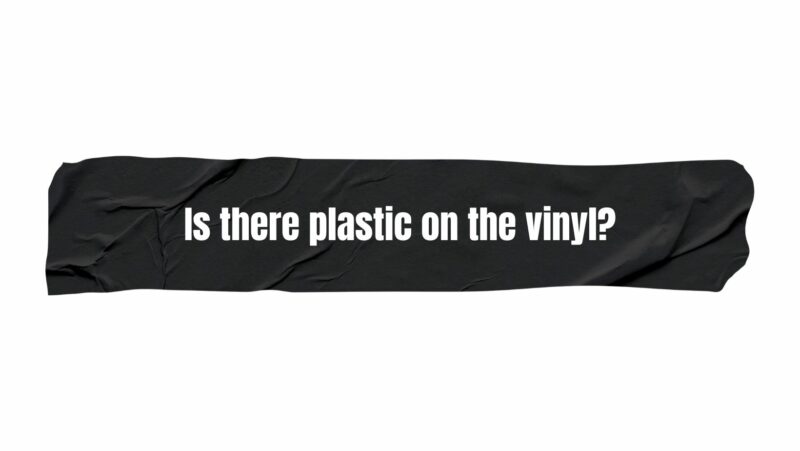Vinyl records, renowned for their warm analog sound and nostalgic appeal, have long been a staple of music collections and cultural history. However, the question of whether there is plastic on vinyl records might seem contradictory at first glance. In this article, we delve into the composition of vinyl records to demystify the material that comprises them. We’ll explore the science behind vinyl records, understanding their unique construction, and addressing the materials used to create these cherished musical artifacts.
Understanding Vinyl Records
To address the question of plastic on vinyl records, it’s crucial to comprehend the construction and composition of these remarkable analog mediums. Vinyl records consist of two primary components: the vinyl disc and the album cover.
The Vinyl Disc: A Closer Look
The vinyl disc is the heart of the record, responsible for storing and reproducing sound. Contrary to popular belief, the term “vinyl” does indeed refer to a type of plastic. Vinyl records are primarily made from a type of plastic known as polyvinyl chloride, or PVC. PVC is a synthetic polymer that’s widely used for various applications due to its durability, flexibility, and ease of manufacturing.
How Vinyl Records Are Made
- Mastering: The creation of a vinyl record begins with a master recording, typically in digital form. This recording is then used to create a physical master disc that contains the grooves representing the soundwaves.
- Plating: The master disc is used to create a metal stamper through an electroplating process. This stamper is what will ultimately press the grooves into the vinyl.
- Pressing: The stamper is placed between two plates, and vinyl pellets are heated and molded into the familiar shape of a vinyl record. The grooves are pressed into the vinyl during this process.
- Cooling and Inspection: The newly formed record is cooled and inspected for quality control. The labels are then applied, completing the pressing process.
The PVC material used in vinyl records is a type of plastic, but it’s important to note that not all plastics are created equal. The PVC used in vinyl records is formulated to have specific characteristics that make it suitable for audio storage and playback.
The Album Cover: Protection and Presentation
The album cover is another integral component of vinyl records. It serves as both protection for the vinyl disc and a canvas for artistic expression. Album covers are typically made from a variety of materials, including paperboard, cardboard, and paper. The front cover often features artwork, band names, and album titles, contributing to the visual identity of the record.
Is There Plastic on Vinyl Records?
In essence, yes, there is plastic on vinyl records. The vinyl disc itself is made from polyvinyl chloride (PVC), a type of plastic material. However, it’s important to clarify that when people refer to “plastic on vinyl records,” they are often alluding to the protective shrink wrap that encases the album cover.
Shrink Wrap and Vinyl Records
Shrink wrap is a thin plastic film that is used to protect various products, including vinyl records. Shrink wrap serves as a barrier against dust, moisture, and physical damage during shipping and storage. It also helps keep the album cover and vinyl in pristine condition until they reach the hands of the collector.
The Role of Shrink Wrap
Shrink wrap is applied to vinyl records during the manufacturing and packaging process. It is heated to create a tight seal around the album cover, ensuring that the record remains protected. This plastic covering is often a temporary measure intended to safeguard the record until it is purchased and opened by the collector.
Removing Shrink Wrap
The decision to remove shrink wrap from vinyl records is a topic of debate among collectors. Some choose to remove it to fully appreciate the artwork and tactile experience, while others prefer to keep it intact to maintain the album’s “mint” condition. If removed carefully, shrink wrap can be taken off without causing damage to the album cover.
Conclusion
The question of whether there is plastic on vinyl records is multifaceted. Vinyl records are primarily made from polyvinyl chloride (PVC), a type of plastic material that forms the vinyl disc. The use of PVC contributes to the records’ durability and ability to reproduce audio faithfully. Additionally, the protective shrink wrap that encases vinyl records is indeed a type of plastic that serves as a temporary barrier against dust, moisture, and handling damage.
Understanding the materials that comprise vinyl records enhances our appreciation of these timeless musical artifacts. From the science behind PVC-based vinyl discs to the protective role of shrink wrap, every component plays a part in preserving the artistry and history of vinyl records. Whether relishing the warm analog sound or admiring album cover artwork, vinyl records remain a bridge between music, art, and nostalgia.


